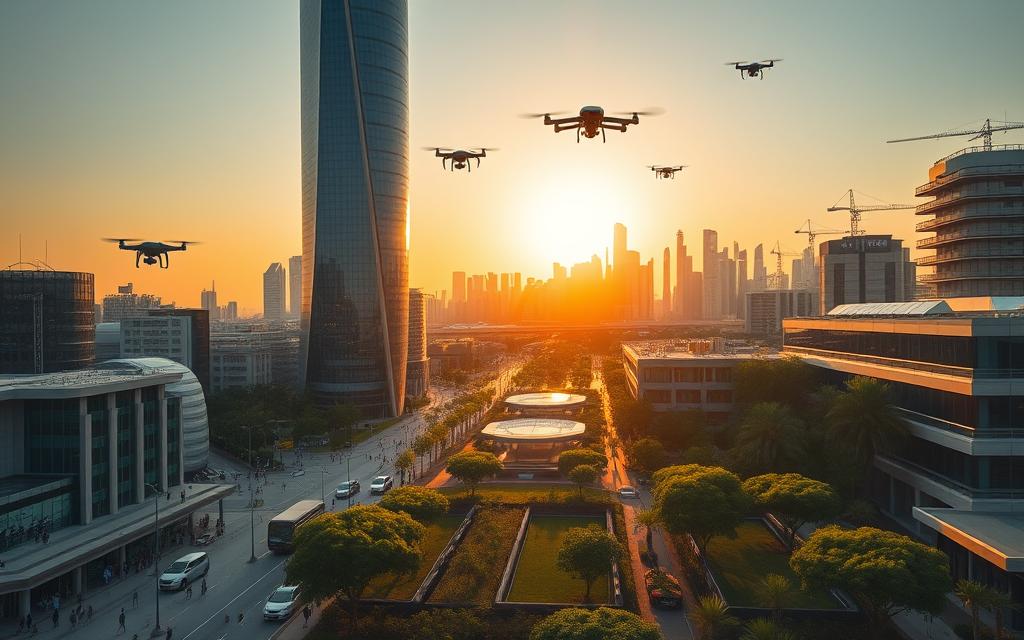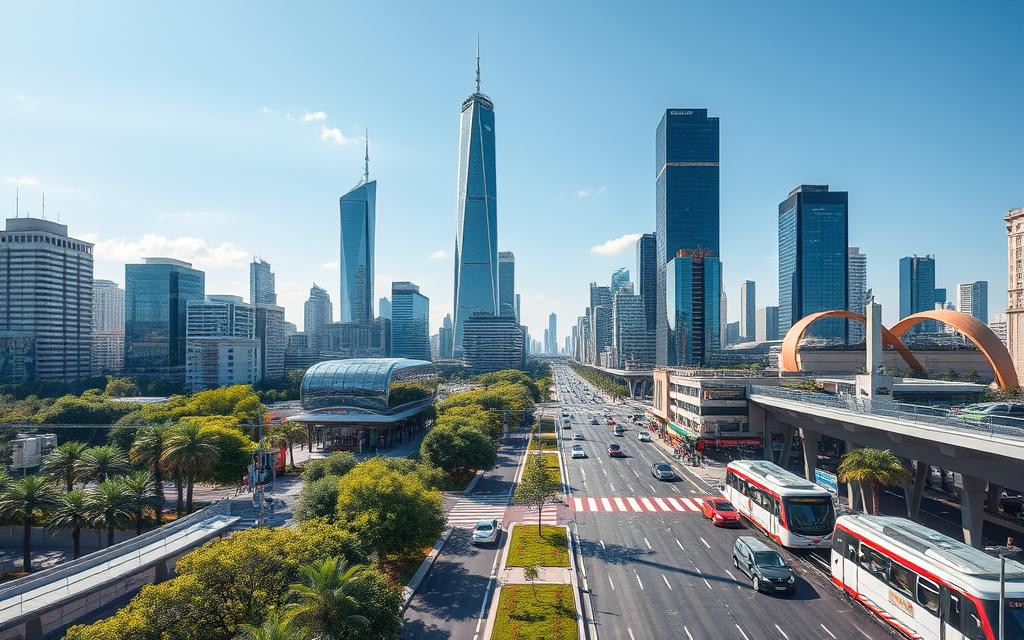As urban populations continue to grow, the concept of smart cities is becoming increasingly important. The integration of digital transformation in urban planning is revolutionizing the way we live, work, and interact with our surroundings.
The future of cities is being shaped by innovative solutions that prioritize sustainability and efficiency. From intelligent transportation systems to smart energy grids, urban development is being redefined.
As we move forward, it’s clear that the successful digital transformation of cities will depend on the effective integration of technology, data, and community needs. This article will explore the key themes shaping the future of urban living.
The Evolution of Urban Landscapes: From Traditional to Smart Cities
The transformation of urban landscapes into smart cities is a significant shift in modern urban planning. This evolution is driven by the need for more efficient, sustainable, and livable cities.
Defining Smart Cities in the Modern Context
Smart cities utilize advanced technology, including IoT devices and data analytics, to improve infrastructure, public services, and the overall quality of life for citizens. Urban innovation is at the forefront of this transformation, enabling cities to become more responsive to the needs of their inhabitants.

Historical Development of Urban Technology Integration
The integration of technology in urban planning is not a new phenomenon. Historically, cities have adapted to technological advancements to improve living conditions. From the introduction of sewage systems to the implementation of traffic management systems, technology has played a crucial role in shaping urban environments.
| Era | Technological Advancements | Impact on Urban Planning |
|---|---|---|
| Industrial Revolution | Mechanization and mass production | Rapid urbanization and infrastructure development |
| Digital Age | Internet, IoT, and data analytics | Smart city initiatives and enhanced public services |
The historical context provides a foundation for understanding the current state of urban technology integration and its potential future developments.
Core Technologies Powering Smart Urban Environments
Smart urban environments rely on a combination of cutting-edge technologies to function efficiently. These technologies work together to create a seamless and connected experience for citizens, enhancing the quality of urban living.

Internet of Things (IoT): The Backbone of Connected Cities
The Internet of Things (IoT) is a network of interconnected devices that collect and exchange data. In smart cities, IoT devices are used to monitor and manage various urban systems, such as traffic management, waste management, and energy usage. This connectivity enables cities to respond to challenges more effectively and improve the overall citizen experience.
Big Data Analytics: Making Sense of Urban Information
Big data analytics plays a crucial role in making sense of the vast amounts of data generated by IoT devices and other urban systems. By analyzing this data, cities can gain insights into patterns and trends, enabling data-driven decision-making and more efficient urban planning.
Artificial Intelligence and Machine Learning Applications
Artificial intelligence (AI) and machine learning (ML) are used to predict and manage various urban systems. AI and ML algorithms can analyze data from IoT devices and other sources to identify patterns and make predictions, enabling proactive measures to be taken to address urban challenges.
These core technologies are interconnected and crucial for the functioning of smart cities. By leveraging IoT, big data analytics, AI, and ML, cities can create a more sustainable, efficient, and livable environment for their citizens.
Reimagining Transportation in Tomorrow’s Cities
As cities evolve, the way we move within them is being reimagined through cutting-edge technologies. The transportation landscape is shifting towards a more efficient, sustainable, and connected ecosystem.

Autonomous Vehicles and Their Urban Integration
Autonomous vehicles are set to revolutionize urban mobility by enhancing safety and reducing congestion. These vehicles use a combination of sensors, GPS, and AI to navigate through city streets, potentially decreasing the number of accidents caused by human error.
Smart Traffic Management Systems
Smart traffic management systems utilize real-time data and analytics to optimize traffic flow, reducing congestion and lowering emissions. By intelligently managing traffic signals and routes, cities can improve the overall efficiency of their transportation networks.
Micro-Mobility Solutions and Last-Mile Connectivity
Micro-mobility solutions, such as e-bikes and scooters, are gaining popularity as a convenient and environmentally friendly option for last-mile connectivity. These solutions help bridge the gap between public transportation and final destinations, making urban travel more seamless.
The integration of these technologies is transforming urban mobility, making it more efficient, sustainable, and user-friendly. As cities continue to adopt and refine these innovations, the future of transportation looks increasingly promising.
Smart Cities: How Will Technology Change the Face of Our Daily Lives?
The future of urban living is being rewritten by technology, making our daily lives more efficient and connected. As we step into the era of smart cities, it’s essential to understand how technology will transform our daily routines and experiences.
Transforming Daily Routines Through Connectivity
The integration of technology in smart cities will revolutionize our daily routines by enhancing connectivity. With the Internet of Things (IoT) at its core, cities will become more responsive to the needs of their citizens. For instance, smart traffic lights can adjust their timing based on real-time traffic conditions, reducing congestion and commute times.
Moreover, smart home technologies will allow residents to control their living environments remotely, optimizing energy consumption and improving comfort. This level of connectivity will not only make daily commutes more efficient but also enhance the overall quality of life.
Personalized Urban Experiences Through Data
Data analytics will play a crucial role in creating personalized urban experiences. By analyzing data from various sources, cities can tailor services to meet the specific needs of their residents. For example, data on usage patterns can help in optimizing public transportation, making it more reliable and efficient.
Furthermore, personalized services can be offered through smart city apps, providing citizens with relevant information and services based on their preferences and behaviors. This not only enhances the urban experience but also fosters a more engaged and participatory community.
As technology continues to evolve, it’s clear that smart cities will significantly impact our daily lives, making them more convenient, sustainable, and enjoyable.
Smart Homes and Buildings: The Building Blocks of Connected Cities
As urban landscapes evolve, smart homes and buildings are becoming the cornerstone of connected cities. The integration of technology into residential and commercial properties is transforming the way we live and work, making our environments more efficient, sustainable, and enjoyable.
Residential Smart Technology Integration
Smart homes are equipped with advanced technologies that enhance the living experience. IoT integration allows for seamless control over lighting, heating, and security systems, making homes more comfortable and energy-efficient. Residents can manage their homes remotely through smartphones, receiving alerts and updates on their property’s status.
The use of smart home devices is on the rise, with devices like Amazon Echo and Google Home becoming increasingly popular. These devices not only provide convenience but also contribute to a more sustainable lifestyle by optimizing energy consumption.
Commercial Buildings and Workplace Transformation
Commercial buildings are also undergoing a significant transformation. Smart building technologies are being adopted to improve workplace environments, enhancing productivity and employee satisfaction. Smart lighting and climate control systems adjust to the needs of occupants, creating a more comfortable workspace.
Furthermore, smart buildings are equipped with advanced security systems, including biometric authentication and surveillance cameras, ensuring a safe working environment. The integration of these technologies is not only improving operational efficiency but also contributing to the well-being of occupants.
Environmental Sustainability in Urban Ecosystems
Environmental sustainability is a critical component in the evolution of urban ecosystems, transforming how cities operate and interact with their inhabitants. As urban populations continue to grow, the need for sustainable practices becomes increasingly urgent.
One of the key strategies in achieving environmental sustainability is through the implementation of smart grids and the integration of renewable energy sources. This not only reduces reliance on fossil fuels but also enhances energy efficiency across the urban landscape.
Smart Grids and Renewable Energy Integration
Smart grids play a pivotal role in managing energy distribution, allowing for real-time adjustments based on demand. By incorporating renewable energy sources such as solar and wind power, cities can significantly reduce their carbon footprint.
Water Management and Conservation Technologies
Effective water management is crucial for urban sustainability. Technologies such as smart metering and advanced irrigation systems help in conserving water, reducing waste, and ensuring that this vital resource is used efficiently.
Waste Reduction and Smart Recycling Systems
Waste reduction and recycling are essential components of a sustainable urban ecosystem. Implementing smart recycling systems that use data analytics to optimize collection routes and processes can significantly reduce the environmental impact of waste disposal.
| Strategy | Description | Impact |
|---|---|---|
| Smart Grids | Real-time energy distribution management | Reduced energy waste, increased efficiency |
| Water Management Technologies | Smart metering and advanced irrigation | Water conservation, reduced waste |
| Smart Recycling Systems | Data analytics for optimized waste collection | Reduced environmental impact, increased recycling rates |
By integrating these strategies, cities can move towards a more sustainable future, enhancing the quality of life for their inhabitants while minimizing their environmental footprint.
Digital Infrastructure: The Invisible Framework Supporting Smart Cities
Digital infrastructure is the unseen force driving the development of smart cities worldwide. As urban areas continue to evolve, the need for robust, efficient, and scalable digital infrastructure becomes increasingly critical.
The digital backbone of a smart city encompasses various technologies that enable the collection, processing, and analysis of data. This infrastructure is crucial for supporting the myriad devices and systems that make up a smart city’s ecosystem.
5G and Beyond: Communication Networks of Tomorrow
The advent of 5G networks marks a significant milestone in the development of smart cities. With faster data transfer rates and lower latency, 5G enables the efficient communication between devices that is essential for smart city operations. As we look beyond 5G, the development of future communication networks will continue to enhance the capabilities of urban infrastructure.
Cloud Computing and Edge Processing in Urban Settings
Cloud computing and edge processing are two complementary technologies that are transforming the way data is managed in smart cities. Cloud computing provides a centralized platform for data storage and analysis, while edge processing enables real-time data processing at the edge of the network, closer to where data is generated.
| Technology | Function | Benefits |
|---|---|---|
| 5G Networks | High-speed data transfer | Enhanced device communication, lower latency |
| Cloud Computing | Centralized data storage and analysis | Scalable data management, improved insights |
| Edge Processing | Real-time data processing | Faster decision-making, reduced latency |
As smart cities continue to evolve, the importance of robust digital infrastructure will only continue to grow. By leveraging technologies like 5G, cloud computing, and edge processing, cities can create a more efficient, sustainable, and connected urban environment.
Enhancing Public Safety and Security Through Technology
As cities evolve into smart urban environments, enhancing public safety and security through technology becomes increasingly crucial. The integration of advanced technologies is transforming the way cities approach safety, making them more proactive and responsive to potential threats.
Predictive Policing and Emergency Response Systems
Predictive policing uses data analytics and machine learning algorithms to identify potential crime hotspots and prevent criminal activity before it occurs. This proactive approach enables law enforcement agencies to allocate resources more effectively, reducing response times and improving overall public safety.
Emergency response systems are also being enhanced through technology, with real-time data analytics and communication networks enabling faster and more coordinated responses to emergencies.
| Technology | Application | Benefit |
|---|---|---|
| Predictive Policing | Crime prevention through data analytics | Reduced crime rates |
| Emergency Response Systems | Real-time data analytics for emergency response | Faster response times |
Surveillance Technologies: Balancing Safety and Privacy
Surveillance technologies, including CCTV cameras and facial recognition software, play a critical role in enhancing public safety. However, their implementation raises important questions about privacy and data protection.
To strike a balance between safety and privacy, cities are implementing regulations and guidelines that ensure surveillance technologies are used responsibly and with transparency.
Citizen Engagement and Community Participation
Smart cities are not just about technology; they’re also about empowering their citizens. The success of a smart city initiative heavily relies on the active participation and engagement of its community. By leveraging digital tools and platforms, cities can foster a more inclusive and participatory governance model.
Digital Democracy and Decision-Making Platforms
Digital democracy platforms enable citizens to participate in decision-making processes through online voting, surveys, and discussion forums. These platforms not only increase citizen engagement but also provide policymakers with valuable insights into community needs and preferences. By embracing digital democracy, cities can become more responsive to the needs of their citizens.
Smart City Apps and User-Centered Design
Smart city apps are designed to make urban living more convenient and efficient. However, their success depends on user-centered design principles that prioritize the needs and preferences of citizens. By involving citizens in the design process, cities can develop apps that are more intuitive, accessible, and effective in addressing urban challenges.
By focusing on citizen engagement and community participation, smart cities can create a more collaborative and inclusive environment. This not only enhances the quality of life for citizens but also contributes to the overall sustainability and resilience of urban ecosystems.
Economic Transformation in Smart Urban Ecosystems
As cities become smarter, they’re experiencing a profound economic shift, characterized by the emergence of novel industries and job roles. This transformation is driven by the integration of advanced technologies into urban infrastructure, leading to more efficient, sustainable, and livable cities.
New Business Models and Economic Opportunities
The smart city ecosystem fosters innovation and entrepreneurship, giving rise to new business models that capitalize on urban data and IoT technologies. For instance, smart energy management systems and smart transportation solutions are creating new revenue streams for cities and companies alike.
Workforce Evolution and Future Skills
The economic transformation in smart cities necessitates a workforce evolution, with a growing demand for skills in data analytics, AI, and IoT technologies. As automation replaces some jobs, new roles emerge that require adaptability and continuous learning.
Public-Private Partnerships in Smart City Development
Public-private partnerships (PPPs) play a crucial role in smart city development, enabling the collaboration of government agencies, private companies, and startups to drive innovation and investment. PPPs can accelerate the deployment of smart city technologies and ensure their sustainable operation.
| Aspect | Traditional City | Smart City |
|---|---|---|
| Economic Growth | Limited by infrastructure | Driven by innovation and technology |
| Workforce | Traditional skill sets | Emerging tech skills |
| Partnerships | Primarily government-led | Public-private collaborations |
Challenges and Concerns in Smart City Implementation
The implementation of smart cities is not without its hurdles, including issues related to accessibility and data privacy. As urban areas become increasingly connected, it’s crucial to address these challenges to ensure that the benefits of smart cities are equitably distributed.
Digital Divide and Accessibility Issues
One of the significant challenges facing smart cities is the digital divide. This refers to the disparity between those who have access to modern information and communication technologies and those who do not. Ensuring that all citizens have equal access to digital technologies is crucial for the inclusive development of smart cities.
Privacy, Data Ownership, and Cybersecurity
Another concern is the issue of privacy, data ownership, and cybersecurity. As cities collect vast amounts of data, there is a growing need to protect citizens’ privacy and ensure the security of this data. Implementing robust cybersecurity measures and transparent data governance policies is essential.
Governance, Regulation, and Ethical Considerations
Effective governance and regulation are critical to the success of smart city initiatives. This includes establishing clear policies on data use, ensuring compliance with existing regulations, and addressing ethical considerations related to surveillance and data collection.
By addressing these challenges and concerns, cities can create more equitable, secure, and efficient urban environments that benefit all citizens.
Conclusion: Embracing the Smart Urban Future
The future of cities is being shaped by technology, innovation, and a commitment to sustainability. As we have explored, smart cities are transforming urban landscapes, making them more livable, efficient, and connected. The integration of Internet of Things (IoT), big data analytics, and artificial intelligence is revolutionizing the way cities operate, making them more responsive to the needs of their citizens.
At the heart of this transformation is the pursuit of a smart urban future, where digital innovation and sustainability converge. Future cities will be characterized by their ability to balance technological advancement with environmental stewardship, ensuring a high quality of life for their inhabitants. This vision for future cities is not just about adopting new technologies but about creating ecosystems that are resilient, inclusive, and sustainable.
As we move forward, it is crucial that stakeholders, including governments, businesses, and citizens, collaborate to drive this vision forward. By embracing digital innovation and prioritizing sustainability, we can create cities that are not only smart but also equitable and thriving. The journey towards a smart urban future is complex, but with continued investment in technology and a commitment to the well-being of citizens, we can build cities that are truly fit for the future.




